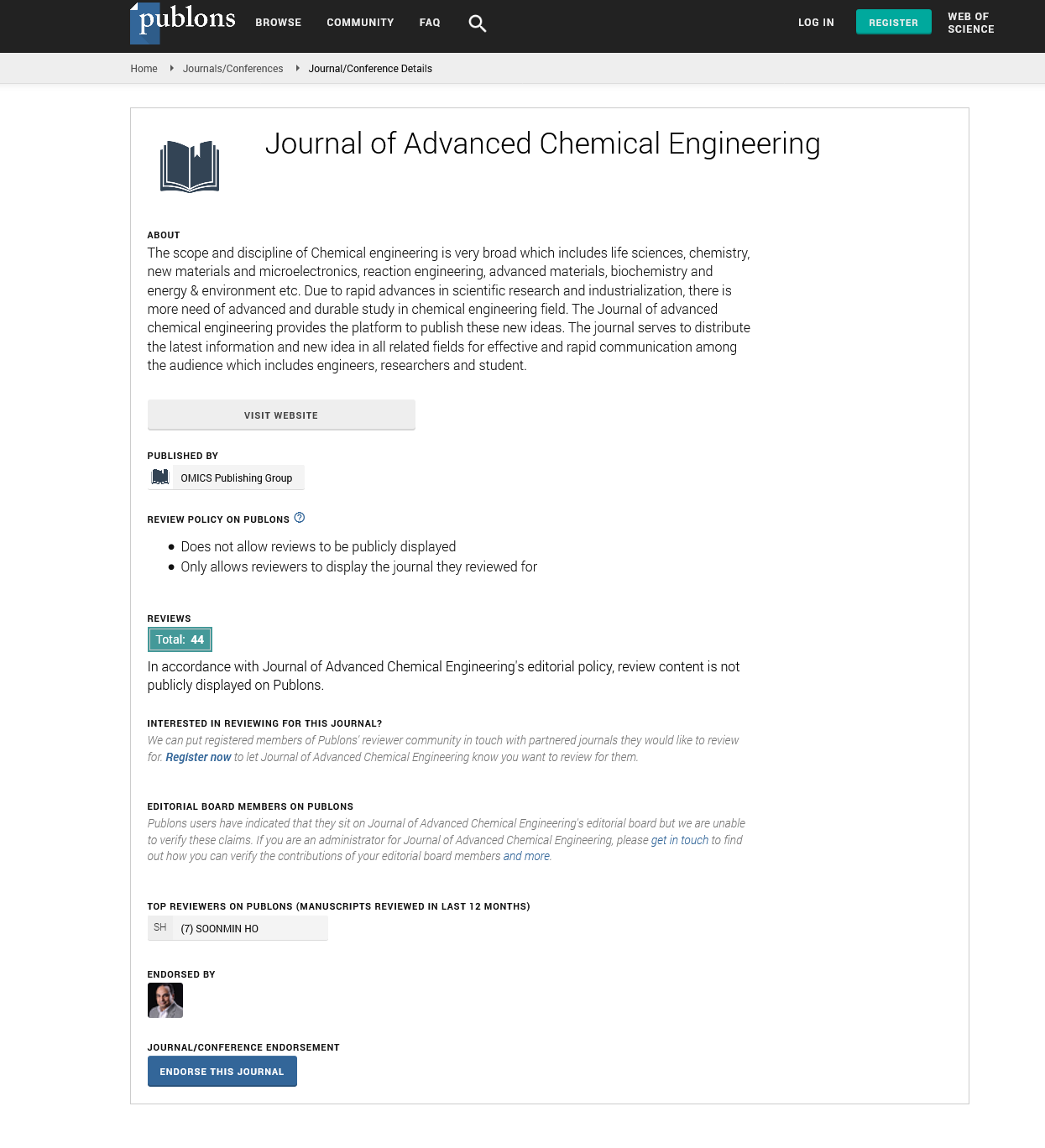Indexed In
- Open J Gate
- Genamics JournalSeek
- Smithers Rapra
- RefSeek
- Directory of Research Journal Indexing (DRJI)
- Hamdard University
- EBSCO A-Z
- OCLC- WorldCat
- Scholarsteer
- Publons
- Geneva Foundation for Medical Education and Research
- Google Scholar
Useful Links
Share This Page
Journal Flyer

Open Access Journals
- Agri and Aquaculture
- Biochemistry
- Bioinformatics & Systems Biology
- Business & Management
- Chemistry
- Clinical Sciences
- Engineering
- Food & Nutrition
- General Science
- Genetics & Molecular Biology
- Immunology & Microbiology
- Medical Sciences
- Neuroscience & Psychology
- Nursing & Health Care
- Pharmaceutical Sciences
Opinion - (2022) Volume 12, Issue 2
A Note Describing Effective Ways of Saponification
Matthew Lundy*Received: 02-Feb-2022, Manuscript No. ACE-22-15878; Editor assigned: 04-Feb-2022, Pre QC No. ACE-22-15878(PQ); Reviewed: 18-Feb-2022, QC No. ACE-22-15878; Revised: 21-Feb-2022, Manuscript No. ACE-22-15878(R); Published: 28-Feb-2022, DOI: 10.35248/2090-4568.22.12.211
Description
Saponification is the process in which triglycerides are mixed with a strong base to obtain fatty acid metal salts during process of soap-making. The distribution of unsaturated and saturated fatty acid signifies the hardness, aroma, cleansing, lather, and moisturizing abilities of soaps. Plant extracts, such as rosemary, vegetable, and essential oils are gently added to soaps to give quality and sensory attire. Three natural soaps were formulated using cold saponification to produce a control bar, hibiscus rosehip bar, and a forest grove bar. Rosemary extract or essential oil blends were added as combinations to each formulation prior to curing to evaluate the effects of natural plant supplement on the lipid composition and sensory characteristics of these natural herbal soaps. A total of seven natural soaps, three without supplements and four with supplements, were manufactured and studied. The majority (86%–99%) of the polyunsaturated fatty acids (5.0–7.0 μg/mg) stays unsaponified in the manufactured natural soaps regardless of feedstock used. Principal component analysis analyses derived the unsaponifiable fatty acids were dissimilar in the hibiscus bar compared to the other bars. There was a very strong difference between the content of unsaponified C18:3n3 and C18:1n9 in all natural soaps. These results show that unsaponified fatty acids are important supplements to the quality and overall sensory perception and preference of natural herbal soaps following manufacturing process by cold saponification. Present trends in consumer desires have shown an increase in demand for the use of natural ingredients in personal skin care and cosmetics products. This has resulted in a steady increase in small- and medium-sized artisan hand-made or homemade soap businesses offering a various products with a range of nature supply ingredients to supply this market. Formulation of specialty hand-made natural soap bars by soap makers involves a expertise combination of the ingredients, thoughts, and innovation to produce high-quality soap bars with superior sensory characteristics that resonates with consumers.
How saponification happens ?
Soap making is a simple method, and its likely should have many of the ingredients and tools. However, it requires careful and accurate measurements, if using chemicals, some of which can be dangerous.
Saponification is an exothermic chemical reaction which means that it gives off heat or produces heat that occurs when fats or oils come into contact with a base. In this reaction, the triglyceride units of fats are reacted with sodium hydroxide or potassium hydroxide and are converted to soap and glycerol. For some types of soap, salt is added to precipitate the solid soap.
The saponification generally consumes about 24 to 48 hours to be processed once the lye and oils have been mixed and the raw soap has been poured into the mold. This process can be sped up by adding more heat or slowed down by keeping the process cold.
Soap making calculator
Oils and fats each have “saponification value” which is the amount of lye needed to completely neutralize them into the soap with no lye left over. Each oil has its different unique value, which is important to run soap recipes through a lye calculator. The calculator gives an assurance that the ratios of water, oils, and lye are correct and will produce the results.
Effect of ingredients
There are several variables that will effect saponification and different soap ingredients have very unique characteristics. Research the types of fatty acids you are using (for example, coconut oil, olive oil, etc.) and the results they may have on the final product. Depending on the ingredients used, soaps can vary greatly with different attributes such as lather, bar consistency, and cleansing ability.
Most of the ingredients for soap making can be found in a grocery store. It is mandatory to buy pure high-quality lye that is made specifically for soap-making. In addition to the basic soap ingredients, there are many options that can be added to the soap to alter the fragrance, consistency, and color of the soap. Once the basic soap-making has proven successful, try experimenting with other soap variations.
Storing the soap
Homemade soap should be left to dry in air for approximately five or six weeks. This is known as curing time, this will allow for any excess water to evaporate out of the soap. Soap should be kept in a cool or dry location, not touching anything while it is drying.
Citation: Lundy M (2022) A Note Describing Effective Ways of Saponification. J Adv Chem. 12:211
Copyright: © 2022 Lundy M. This is an open-access article distributed under the terms of the Creative Commons Attribution License, which permits unrestricted use, distribution, and reproduction in any medium, provided the original author and source are credited.

